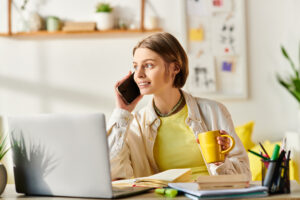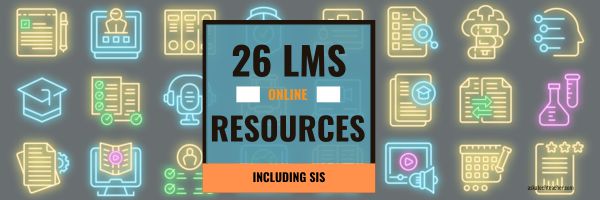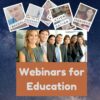Category: Classroom management
Tech Tips to End the School Year
Wrapping up your school technology for the summer is as complicated as setting it up in September. There are endless backups, shares, cleanings, changed settings, and vacation messages that — if not done right — can mean big problems when you return from summer vacation. If you have a school device, a lot of the shutdown steps will be done by the IT folks as they backup, clean, reformat, and maybe re-image your device. If you have a personal device assigned by the school but yours to take home, the steps may be more numerous but really, not more complicated.
Here’s a list. Skip those that don’t apply to you and complete the rest. I won’t take time in this article for a how-to on each activity so if you don’t know how to complete one, check with your IT folks or DDG (Duck Duck Go–or Google) it:
Share this:
- Click to share on Facebook (Opens in new window) Facebook
- Click to share on X (Opens in new window) X
- Click to share on LinkedIn (Opens in new window) LinkedIn
- Click to share on Pinterest (Opens in new window) Pinterest
- Click to share on Telegram (Opens in new window) Telegram
- Click to email a link to a friend (Opens in new window) Email
- More
Flowers in the Classroom: Blossoming Learning with Tech
Flowers spark creativity and learning in classrooms. Today, the Ask a Tech Teacher international team is exploring how flowers inspire students in STEM, art, and ecology, how a bouquet can enhance tech-driven education and classroom joy. Learn how they blend with tech tools and can brighten educational spaces.
Petals and Pixels: Flowers in Tech-Savvy Classrooms
Imagine a classroom where sunflowers nod on a windowsill during a coding lesson, or a science lab where students dissect daisies while a tablet app tracks their findings. Flowers bring a vibrant energy to education, bridging nature and technology in ways that captivate young minds. They inspire projects, from digital art to ecological studies, and foster a welcoming space for learning. They connect abstract concepts to tangible beauty, making lessons stick. To weave that magic into any classroom, anyone can order a bouquet of flowers and have it delivered, ideal for sparking inspiration or gifting to a teacher.
Flowers fit seamlessly into tech-driven education. They fuel curiosity in STEM experiments, add depth to creative assignments, and soften the hum of devices with natural charm. They’re tools for engagement, helping students explore science, art, and community through hands-on and digital means, all while keeping the classroom lively. (more…)
Share this:
- Click to share on Facebook (Opens in new window) Facebook
- Click to share on X (Opens in new window) X
- Click to share on LinkedIn (Opens in new window) LinkedIn
- Click to share on Pinterest (Opens in new window) Pinterest
- Click to share on Telegram (Opens in new window) Telegram
- Click to email a link to a friend (Opens in new window) Email
- More
Is the Traditional Classroom Becoming Obsolete?
Something broke in American education these past years. Too many students don’t reach grade-level metrics and no one can agree on the cause. I went out to our international contributors for ideas. They had a lot, but this one I thought I’d cover first:
Is the Traditional Classroom Becoming Obsolete?
You might argue that the traditional classroom still plays an essential role in education, but the rapid growth of online and hybrid models suggests otherwise. As students increasingly seek flexible and interactive learning experiences, the conventional approach may not meet their needs any longer. This shift raises critical questions about the future of education: How will teachers adapt their roles? What innovations might redefine the learning environment? Understanding these dynamics could reshape your perspective on what effective education looks like today.
The Rise of Online Learning
Online learning has increasingly become a staple in education, with studies showing that over 30% of students now prefer it over traditional classroom settings. This shift raises questions about the efficacy and long-term viability of conventional education methods. You might wonder why this preference exists. Data indicates that online learning offers flexibility that traditional classrooms often can’t match.
Students can learn at their own pace, tailoring the experience to their unique needs, which can enhance engagement and retention.
However, you should also consider the challenges that accompany this rise. Not all online platforms deliver quality education, and the lack of face-to-face interaction can hinder social development and collaborative skills. Reports highlight that many students struggle with self-discipline in an online environment, leading to higher dropout rates compared to traditional settings.
Moreover, issues like digital divide—where not all students have equal access to technology—raise concerns about equity in education.
Ultimately, while online learning’s popularity is undeniable, it’s essential to analyze its limitations and implications critically. As you explore this educational landscape, understanding both the advantages and drawbacks will be vital in determining the future of learning. (more…)
Share this:
- Click to share on Facebook (Opens in new window) Facebook
- Click to share on X (Opens in new window) X
- Click to share on LinkedIn (Opens in new window) LinkedIn
- Click to share on Pinterest (Opens in new window) Pinterest
- Click to share on Telegram (Opens in new window) Telegram
- Click to email a link to a friend (Opens in new window) Email
- More
17 K-8 Digital Citizenship Topics
Education is no longer contained within classroom walls or the physical site of a school building. Learning isn’t confined to the eight hours between the school bell’s chimes or the struggling budget of an underfunded program.
Today, education can be found anywhere, by teaming up with students in Kenya or Skyping with an author in Sweden or chatting with an astrophysicist on the International Space Station. Students can use Google Earth to take a virtual tour of a zoo or a blog to collaborate on class research. Learning has no temporal or geographic borders, and is available wherever students and teachers find an internet connection.
This vast landscape of resources is often free, but this cerebral trek through the online world requires students know how to do it safely, securely, and responsibly. This used to mean limiting access to the internet, blocking websites, and layering rules upon rules hoping (vainly) students would be discouraged from using an infinite and fascinating resource.
It didn’t work.
Best practices now suggest that instead of cocooning students, we teach them to be good digital citizens, confident and competent in 17 areas:
Share this:
- Click to share on Facebook (Opens in new window) Facebook
- Click to share on X (Opens in new window) X
- Click to share on LinkedIn (Opens in new window) LinkedIn
- Click to share on Pinterest (Opens in new window) Pinterest
- Click to share on Telegram (Opens in new window) Telegram
- Click to email a link to a friend (Opens in new window) Email
- More
How to Change the Dynamics of Peer-to-peer Learning
Here’s what most educators and parents innately know as a truism of education:
“If you can’t explain something simply, you don’t understand it well enough.” –Albert Einstein
Peer-to-peer learning–acquiring knowledge from a peer group–has become a popular strategy as teachers move from a “teacher-lecturer” education model to “teacher-guide”. Often, it is a less stressful way to develop lifelong learners. As a pedagogical strategy, it can be effective in reinforcing critical thinking, cooperation, creativity, and problem solving–traits that are difficult to teach but essential for students who want to become productive, happy adults.
What is Peer-to-peer Learning
Peer-to-peer learning is where individuals learn from and with each other rather than relying on a traditional teacher or instructor. It involves collaboration, knowledge sharing, and mutual support among peers—typically people at a similar level of expertise or experience—working together to achieve a common learning goal. Participants exchange ideas, explain concepts, ask questions, and provide feedback. The process fosters critical thinking, communication skills, and a deeper understanding of the subject matter, as teaching others reinforces one’s own knowledge. Examples include study groups, coding boot camps where participants critique each other’s work, or online communities where users share expertise. It’s built on the idea that collective learning can be just as effective, if not more so, than top-down instruction, leveraging diverse perspectives and real-world problem-solving. (more…)
Share this:
- Click to share on Facebook (Opens in new window) Facebook
- Click to share on X (Opens in new window) X
- Click to share on LinkedIn (Opens in new window) LinkedIn
- Click to share on Pinterest (Opens in new window) Pinterest
- Click to share on Telegram (Opens in new window) Telegram
- Click to email a link to a friend (Opens in new window) Email
- More
Random Acts of Kindness Day is Coming. How Will You Celebrate?
A friend of mine told me this story:
“On a chilly winter evening in New York City, Sarah (not her real name) was struggling with the cold and the cost of her subway ride home when an elderly man noticed her plight. Without hesitation, he gave her a fully loaded subway card, explaining he had more than he needed. He also offered her a homemade sandwich, insisting it was no good to waste food. This unexpected kindness brought tears to Sarah’s eyes, warming her not just with the promise of a meal and a ride home, but with the profound reminder of human compassion in an often indifferent world.”
That was one of many Random Acts of Kindness experienced in a world known for just the opposite. Now, February 9-15, 2025 in America is Random Acts of Kindness Week and is when everyone encourages acts of kindness without any expectation of consideration in return.
“Kindness is a language which the deaf can hear and the blind can see.” — Mark Twain
What is Random Acts of Kindness Day?
Random Acts of Kindness (RAK) Day is twenty-four hours when anyone who chooses to participate agrees to perform unexpected acts of kindness to pay it forward for that time they need a little bit of unexpected care. We flaunt our altruistic side by doing something nice for another without a thought for the consequences.
Why is Kindness important?
Why kindness is important seems obvious, but really, it isn’t. I can name a whole lot of people who have succeeded despite being, well, jerks so why should we think there’s merit in a gentler approach?
Share this:
- Click to share on Facebook (Opens in new window) Facebook
- Click to share on X (Opens in new window) X
- Click to share on LinkedIn (Opens in new window) LinkedIn
- Click to share on Pinterest (Opens in new window) Pinterest
- Click to share on Telegram (Opens in new window) Telegram
- Click to email a link to a friend (Opens in new window) Email
- More
New Year, New Mindset
Here’s the outline for a seminar I teach in schools before the holiday break, to excite teachers about what they can accomplish “the second half” of the school year:
Every year, I make New Year resolutions and ignore them. I don’t promise to fulfill them. I don’t even check my progress and revise as needed. I make-and-forget, check it off the New Year’s To Do list and move on.
This year, I’m trying something different: resolutions that aren’t quantified, that won’t take extra time from my too-busy schedule. Resolutions that are, instead, about my teaching mindset. Here’s my list:
I will learn one new tech tool a month
There are so many. I get massive lists of webtools, websites, apps, extensions, and links in my inbox, mostly proclaimed as “the tool I can’t do without”. Every month, I’ll pick one and try it.
Just to be clear: Today’s tech ed tools aren’t like they used to be. The ones I’m interested in are easy-to-use, intuitive, easily differentiated for varied student needs, and free or inexpensive. Anything that requires a time commitment to learn and buckets of creativity to use is off the list. My schedule is too packed for that sort of commitment. And, I’ll unpack them with the students, authentically, as part of a project we do.
To get me started, add a comment with your favorite tool — the one I should start in January.
Share this:
- Click to share on Facebook (Opens in new window) Facebook
- Click to share on X (Opens in new window) X
- Click to share on LinkedIn (Opens in new window) LinkedIn
- Click to share on Pinterest (Opens in new window) Pinterest
- Click to share on Telegram (Opens in new window) Telegram
- Click to email a link to a friend (Opens in new window) Email
- More
How to Put Kindness in Your Classes
World Kindness Day, celebrated on November 13th each year, promotes kindness across the globe and emphasizes compassion toward others. This day encourages us to look beyond boundaries, religions, and cultures, focusing instead on the simple act of being kind. Founded in 1998 by the World Kindness Movement, it is observed in many countries, including the United States, Canada, Australia, Japan, and the United Arab Emirates.
People celebrate World Kindness Day by performing acts of kindness like helping a neighbor, complimenting strangers, volunteering, or spreading messages of positivity and goodwill. Many schools, workplaces, and communities organize events to encourage people to cultivate empathy and generosity.
What is kindness?
Kindness is exactly what it sounds like — being friendly, generous, and considerate to others whether or not you think they deserve it. It’s not a payoff to someone who treated you well; it’s an attitude that seeps into every action in a person’s life.
It’s interesting that some variation of “kindness” is included in most non-academic measures of what students should learn in school, including Habits of Mind, a Growth Mindset, and Mindfulness (click links for further discussion).
Why is it important?
Kids learn by example. It’s unfortunate to note that some don’t see kindness in their homes. What they experience instead, they may think is the norm until you — their trusted teacher — shows them otherwise. This isn’t as easy as it sounds. You must always have your antenna up, noticing when you need to intervene to tweak actions. This could be gossip, mean words, (cyber)bullying, or even speech that is accepted by most because “doesn’t everyone think this way”. Your job isn’t to stop whatever is going on but redirect and explain so students learn why what they’re doing isn’t kind.
Why teach this in school, you ask? The quick answer is that students spend half their waking hours in or around school. It has a huge impact on how they view their world and their lives. But it’s more than that. Establishing a kind school culture resonates in all parts of a child’s life:
“Positive school climate has been empirically linked to a number of favorable outcomes, notably, the promotion of feelings of safety; establishing and maintaining healthy relationships, reductions in misbehavior, increases in students’ academic, emotional, and behavioral success at school; teaching that is engaging and promotes learning, and improvements in the overall quality of schools.” (Measuring Kindness in School, John Tyler Binfet, 2015)
In short, if students see kindness modeled in school, they are more likely to duplicate that in their own lives and activities.
Share this:
- Click to share on Facebook (Opens in new window) Facebook
- Click to share on X (Opens in new window) X
- Click to share on LinkedIn (Opens in new window) LinkedIn
- Click to share on Pinterest (Opens in new window) Pinterest
- Click to share on Telegram (Opens in new window) Telegram
- Click to email a link to a friend (Opens in new window) Email
- More
26 Online LMS Resources
Here are 26 resources to help you select the right LMS for your school (click for updates to list): (more…)
Share this:
- Click to share on Facebook (Opens in new window) Facebook
- Click to share on X (Opens in new window) X
- Click to share on LinkedIn (Opens in new window) LinkedIn
- Click to share on Pinterest (Opens in new window) Pinterest
- Click to share on Telegram (Opens in new window) Telegram
- Click to email a link to a friend (Opens in new window) Email
- More
Warm-ups–Watch the video
Warm-ups
This video is from a series I taught for school districts. It is now available for free, here on Ask a Tech Teacher:
–summarized by NoteGPT
Highlights
- 🖥️ Engaging with technology enhances student learning and excitement.
- 📅 Class warm-ups help transition students into learning mode efficiently.
- ⏱️ Student independence during warm-ups allows teachers to manage other tasks.
- 🎨 Utilizing tools like Smore for creating engaging class materials.
- 📚 Presentation boards encourage student collaboration and sharing.
- 💻 Blogging fosters communication and feedback among classmates.
- 🔄 Responsive classroom activities can be adapted for technology use.
Key Insights
- 🧑🏫 Technology Integration: Effectively using technology in education not only captivates students but also promotes a deeper understanding of the material. Encouraging tech-related engagement can transform traditional lessons into interactive experiences.
- 🎯 Purposeful Warm-Ups: Implementing structured class warm-ups minimizes downtime and maximizes learning. These activities set the tone for the lesson and help students focus as they transition into the learning environment.
- 🤝 Student Empowerment: Allowing students to take charge of their warm-up activities fosters independence. This approach not only builds responsibility but also encourages them to become active participants in their learning journey.
- 📊 Creative Teaching Tools: Utilizing platforms like Smore helps educators design visually appealing and informative materials that enhance communication with students and parents, making learning more accessible.
- 👥 Collaborative Learning: Activities such as presentation boards and blogging promote peer-to-peer learning. This collaboration strengthens their understanding and retention of the material while building a supportive classroom community.
- 🔄 Feedback Mechanisms: Incorporating blog comments or discussion forum posts enables meaningful interaction. This feedback loop enhances the learning process and encourages critical thinking among students.
- 🏫 Responsive Classroom Strategies: Integrating responsive classroom techniques with technology can create an inclusive and engaging learning environment. These strategies help maintain student interest and facilitate smooth transitions during lessons.
Share this:
- Click to share on Facebook (Opens in new window) Facebook
- Click to share on X (Opens in new window) X
- Click to share on LinkedIn (Opens in new window) LinkedIn
- Click to share on Pinterest (Opens in new window) Pinterest
- Click to share on Telegram (Opens in new window) Telegram
- Click to email a link to a friend (Opens in new window) Email
- More






















































